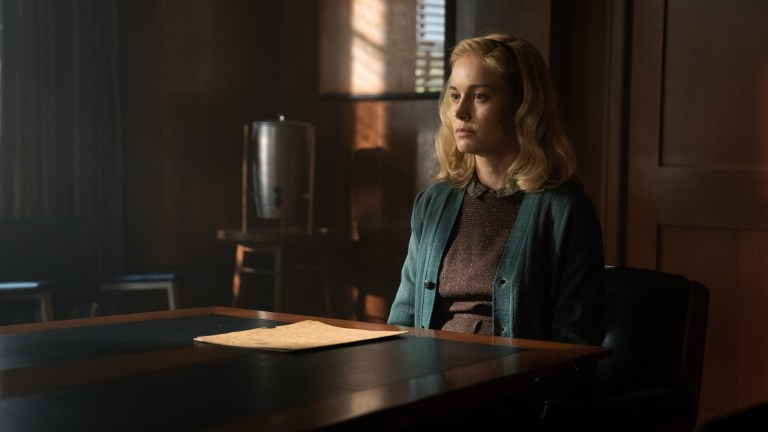Lessons in Chemistry’s Creative Use for Frogs Is Based in Fact
The Apple TV+ series starring Brie Larson has a lesson to teach about the scientific efficacy of frogs and pregnancy.

This article contains spoilers for Lessons in Chemistry episode 3.
Elizabeth Zott is nothing if not resourceful. Her entire kitchen doubles as a lab. She wears a sharpened pencil in her hair as both a helpful writing tool and protective weapon. She knows how to skin a tomato in mere seconds. So it comes as no surprise that, when it comes to at-home reproductive testing, she knows how to get things done with minimal fuss and maximum results.
Following the shocking twist at the conclusion of the first two episodes of Lessons in Chemistry, Elizabeth (Brie Larson) finds herself all alone and struggling to make meaning of her life after her beloved Calvin (Lewis Pullman) dies in a freak accident. Her scientific work is threatened and her emotional life is empty as the only person she felt she could trust is now gone. Given those circumstances, when Elizabeth begins to feel a little pekid, she’s reluctant to seek out any help from external sources. In today’s world, she’d just hop down to her nearest CVS and grab some pregnancy tests, but this being the ‘50s, there’s no such thing.
Before the advent of at-home pregnancy tests in the early 1970’s, women had to rely on other means to find out if they were with child. Many methods were wildly unscientific. Some ladies brought their urine to so-called experts who claimed that they could tell that a woman was pregnant simply from looking at a vial of the stuff. Elizabeth Zott would certainly not approve. So, it makes sense that she would find an empirical way in which to verify her own pregnancy.
A small montage in the episode shows but doesn’t tell what Ms. Zott is up to. She sources syringes, glass cases, and frogs, and finally holes up in a lab restroom in order to gather her own sample. Moments later the camera pans over the two frogs: one is ribbiting away, happy as a clam, and the other has laid an army of tiny eggs. It’s the equivalent of a plus sign or a smiley face on a modern day rapid test. Elizabeth is indeed pregnant. And she’s alone.
As an avid consumer of scientific tomes, Elizabeth would have known about something called the AZ test, or a barbaric precursor to today’s at-home pregnancy tests in which a rabbit or a mouse was injected with a woman’s urine to ascertain whether or not she was pregnant. If the rabbit or mouse went into heat, the woman was pregnant. However, scientists needed to kill and then dissect the animal in order to ascertain that this was the case. Enter, frogs. In 1937, a scientist named Lancelot Hogben discovered that frogs (specifically South African frogs) would visibly produce eggs once the injected urine triggered ovulation, and a cottage industry of frog pregnancy testing soon hopped into place.
As the science caught up, it became obvious that the at-home pregnancy test was something that women desperately wanted. Some women desired to learn this life-altering information in the privacy of their own homes, and others just wanted to know if they had a baby on board as soon as possible. In Elizabeth’s case it’s a bit of the former, but her fears about bringing a baby into the world as a single mother were very real indeed. Could she trust a doctor to test her and treat her well? (Later, when she meets her no-nonsense OBGYN, played by the ever-delightful Marc Evan Jackson, we find out that the answer is yes … but Elizabeth is lucky in that regard.) Does she even want the baby?
Back in the ‘50s, Elizabeth didn’t have much of a choice when it came to keeping or terminating her pregnancy. But she needed to confirm the evidence for herself before making a decision. She performs her DIY frog test approximately two decades before any over-the-counter test would become widely available to women seeking to surreptitiously find out their pregnancy status. In the late 1960’s, a dyad of scientists named Judith Vaitukaitis and Glenn Braunstein cracked the first part of the problem while conducting research at the National Institute of Health. They isolated hCG, a hormone that spikes in the urine when women are pregnant, and then devised a test. Then, a few years later, when cosmetics designer Margaret Crane was touring a lab to research a different product, she came up with the idea for the home test.
Surely, Elizabeth Zott would be heartened that two women contributed so much to the creation and marketing of an at-home pregnancy test — a test that would help women feel more independent and empowered. As a pioneer of such testing — and as an avid scientist herself — Zott would surely cheer the efforts of these scientists who paved the way for women everywhere to learn this sensitive information in the privacy of their own homes. No frogs were harmed in the making of this article.
New episodes of Lessons in Chemistry premiere Fridays on Apple TV+, culminating with the finale on Nov. 24.
